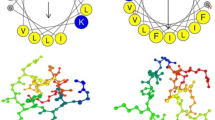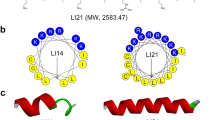Abstract
Pseudomonas aeruginosa is particularly difficult to treat because it possesses a variety of resistance mechanisms and because it often forms biofilms. Antimicrobial peptides represent promising candidates for future templates of antibiotic-resistant bacterial infections due to their unique mechanism of antimicrobial action. In this study, we first found that the antimicrobial peptide Feleucin-K3 has potent antimicrobial activity against not only the standard strain of P. aeruginosa but also against the multidrug-resistant strains isolated from clinics. Then, the structure–activity relationship of the peptide was investigated using alanine and d-amino acid scanning. Among the analogs synthesized, FK-1D showed much more potent antimicrobial activity, superior stability, and very low toxicity, and it was able to permeabilize bacterial membranes. Furthermore, it exhibited significant anti-biofilm activity. More importantly, FK-1D showed excellent antimicrobial activity in vivo, especially against clinical multidrug-resistant bacteria, in contrast to ceftazidime. Our results suggested that FK-1D could be subjected to fixed-point modification in the first and fourth sites to further optimize its medicinal properties and potential as a lead compound for the treatment of infections caused by multidrug-resistant P. aeruginosa and the associated biofilms.






Similar content being viewed by others
References
Batoni G, Maisetta G, Brancatisano FL et al (2011) Use of antimicrobial peptides against microbial biofilms: advantages and limits. Curr Med Chem 18:256–279
Batoni G, Maisetta G, Esin S (2016) Antimicrobial peptides and their interaction with biofilms of medically relevant bacteria. Biochim Biophys Acta 1858:1044–1060
Brooks BD, Brooks AE (2014) Therapeutic strategies to combat antibiotic resistance. Adv Drug Deliv Rev 78:14–27
Cantisani M, Finamore E, Mignogna E et al (2014) Structural insights into and activity analysis of the antimicrobial peptide myxinidin. Antimicrob Agents Chemother 58:5280–5290
Chen YX, Guarnieri MT, Vasil AI et al (2007) Role of peptide hydrophobicity in the mechanism of action of alpha-helical antimicrobial peptides. Antimicrob Agents Chemother 51:1398–1406
Ciociola T, Pertinhez TA, Giovati L et al (2016) Dissecting the structure-function relationship of a fungicidal peptide derived from the constant region of human immunoglobulins. Antimicrob Agents Chemother 60:2435–2442
Clinical and Laboratory Standards Institute (2012) Methods for dilution antimicrobial susceptibility tests for bacteria that grow aerobically: approved standard. M07-A9, vol 9. CLSI, Wayne
de la Fuente-Nunez C, Korolik V, Bains M et al (2012) Inhibition of bacterial biofilm formation and swarming motility by a small synthetic cationic peptide. Antimicrob Agents Chemother 56:2696–2704
de la Fuente-Nunez C, Reffuveille F, Haney EF et al (2014) Broad-spectrum anti-biofilm peptide that targets a cellular stress response. PLoS Pathog 10:e1004152
de la Fuente-Nunez C, Cardoso MH, Candido ED et al (2016) Synthetic antibiofilm peptides. Biochim Biophys Acta 1858:1061–1069
Di Luca M, Maccari G, Nifosì R (2014) Treatment of microbial biofilms in the post-antibiotic era: prophylactic and therapeutic use of antimicrobial peptides and their design by bioinformatics tools. Pathog Dis 70:257–270
Eriksson OS, Georg M, Sjolinder H et al (2013) Identification of cell-penetrating peptides that are bactericidal to Neisseria meningitidis and prevent inflammatory responses upon infection. Antimicrob Agents Chemother 57:3704–3712
Gruenheid S, Le Moual H (2012) Resistance to antimicrobial peptides in Gram-negative bacteria. FEMS Microbiol Lett 330:81–89
Hochbaum AI, Kolodkin-Gal I, Foulston L et al (2011) Inhibitory effects of d-amino acids on Staphylococcus aureus biofilm development. J Bacteriol 193:5616–5622
Hou XJ, Du Q, Li RJ et al (2015) Feleucin-BO1: a novel antimicrobial non-apeptide amide from the skin secretion of the toad, bombina orientalis, and design of a potent broad-spectrum synthetic analogue, Feleucin-K3. Chem Biol Drug Des 85:259–267
Howard JJ, Sturge CR, Moustafa DA et al (2017) Inhibition of Pseudomonas aeruginosa by peptide-conjugated phosphorodiamidate morpholino oligomers. Antimicrob Agents Chemother 61:1–12
Joo HS, Fu CI, Otto M (2016) Bacterial strategies of resistance to antimicrobial peptides. Philos Trans R Soc Lond B Biol Sci 371:1–11
Kim H, Jang JH, Kim SC et al (2014) De novo generation of short antimicrobial peptides with enhanced stability and cell specificity. J Antimicrob Chemother 69:121–132
Lee W, Hwang JS, Lee DG (2015) A novel antimicrobial peptide, scolopendin, from Scolopendra subspinipes mutilans and its microbicidal mechanism. Biochimie 118:176–184
Li XH, Lee JH (2017) Antibiofilm agents: a new perspective for antimicrobial strategy. J Microbiol 55:753–766
Liu YY, Wang Y, Walsh TR et al (2016) Emergence of plasmid-mediated colistin resistance mechanism MCR-1 in animals and human beings in China: a microbiological and molecular biological study. Lancet Infect Dis 16:161–168
Loh B, Grant C, Hancock RE (1984) Use of the fluorescent probe 1-N phenylnaphthylamine to study the interactions of aminoglycoside antibiotics with the outer membrane of Pseudomonas aeruginosa. Antimicrob Agents Chemother 26:546–551
Luca V, Stringaro A, Colone M et al (2013) Esculentin(1–21), an amphibian skin membrane-active peptide with potent activity on both planktonic and biofilm cells of the bacterial pathogen Pseudomonas aeruginosa. Cell Mol Life Sci 70:2773–2786
Maria-Neto S, de Almeida KC, Macedo MLR et al (2015) Understanding bacterial resistance to antimicrobial peptides: from the surface to deep inside. Biochim Biophys Acta 1848:3078–3088
Mauch RM, Jensen PØ, Moser C et al (2018) Mechanisms of humoral immune response against Pseudomonas aeruginosa biofilm infection in cystic fibrosis. J Cyst Fibros 17:143–152
Mohamed MF, Brezden A, Mohammad H et al (2017) A short d-enantiomeric antimicrobial peptide with potent immunomodulatory and antibiofilm activity against multidrug-resistant Pseudomonas aeruginosa and Acinetobacter baumannii. Sci Rep 7:6953
Moradali MF, Ghods S, Rehm BHA (2017) Pseudomonas aeruginosa lifestyle: a paradigm for adaptation, survival, and persistence. Front Cell Infect Microbiol 7:1–29
Mulcahy LR, Isabella VM, Lewis K (2014) Pseudomonas aeruginosa biofilms in disease. Microb Ecol 68:1–12
Myhrman E, Hakansson J, Lindgren K et al (2013) The novel antimicrobial peptide PXL150 in the local treatment of skin and soft tissue infections. Appl Microbiol Biotechnol 97:3085–3096
Nagant C, Pitts B, Nazmi K et al (2012) Identification of peptides derived from the human antimicrobial peptide LL-37 active against biofilms formed by Pseudomonas aeruginosa using a library of truncated fragments. Antimicrob Agents Chemother 56:5698–5708
Nuri R, Shprung T, Shai Y (2015) Defensive remodeling: how bacterial surface properties and biofilm formation promote resistance to antimicrobial peptides. Biochim Biophys Acta 1848:3089–3100
Oglesby-Sherrouse AG, Djapgne L, Nguyen AT et al (2014) The complex interplay of iron, biofilm formation, and mucoidy affecting antimicrobial resistance of Pseudomonas aeruginosa. Pathog Dis 70:307–320
Overhage J, Campisano A, Bains M et al (2008) Human host defense peptide LL-37 prevents bacterial biofilm formation. Infect Immun 76:4176–4182
Pawar V, Komor U, Kasnitz N et al (2015) In vivo efficacy of antimicrobials against biofilm-producing Pseudomonas aeruginosa. Antimicrob Agents Chemother 59:4974–4981
Pletzer D, Hancock REW (2016) Antibiofilm peptides: potential as broad-spectrum agents. J Bacteriol 198:2572–2578
Potron A, Poirel L, Nordmann P (2015) Emerging broad-spectrum resistance in Pseudomonas aeruginosa and Acinetobacter baumannii: mechanisms and epidemiology. Int J Antimicrob Agents 45:568–585
Qian CD, Wu XC, Teng Y et al (2012) Battacin (Octapeptin B5), a new cyclic lipopeptide antibiotic from Paenibacillus tianmuensis active against multidrug-resistant Gram-negative bacteria. Antimicrob Agents Chemother 56:1458–1465
Reffuveille F, de la Fuente-Nunez C, Mansour S et al (2014) A broad-spectrum antibiofilm peptide enhances antibiotic action against bacterial biofilms. Antimicrob Agents Chemother 58:5363–5371
Ribeiro SM, Felicio MR, Boas EV et al (2016) New frontiers for anti-biofilm drug development. Pharmacol Ther 160:133–144
Rodriguez-Granillo A, Annavarapu S, Zhang L et al (2011) Computational design of thermostabilizing d-amino acid substitutions. J Am Chem Soc 133:18750–18759
Rybtke M, Hultqvist LD, Givskov M et al (2015) Pseudomonas aeruginosa biofilm infections: community structure, antimicrobial tolerance and immune response. J Mol Biol 427:3628–3645
She PF, Chen LH, Liu HB et al (2015) The effects of d-Tyrosine combined with amikacin on the biofilms of Pseudomonas aeruginosa. Microb Pathog 86:38–44
Skariyachan S, Sridhar VS, Packirisamy S et al (2018) Recent perspectives on the molecular basis of biofilm formation by Pseudomonas aeruginosa and approaches for treatment and biofilm dispersal. Folia Microbiol (Praha) 63:413–432
Xie JQ, Zhao Q, Li SS et al (2017) Novel antimicrobial peptide CPF-C1 analogs with superior stabilities and activities against multidrug-resistant bacteria. Chem Biol Drug Des 90:690–702
Zhang QH, Xu YZ, Wang Q et al (2015) Potential of novel antimicrobial peptide P3 from bovine erythrocytes and its analogs to disrupt bacterial membranes in vitro and display activity against drug-resistant bacteria in a mouse model. Antimicrob Agents Chemother 59:2835–2841
Acknowledgements
This work was supported by the National Natural Science Foundation of China (81602945, 81673283, and 81473095), the Program for Ministry of Education “Peptide Drugs” Innovation Team (IRT_15R27), the China Postdoctoral Science Foundation (2016M592593), and the Fundamental Research Funds for the Central Universities (lzujbky-2017-k11, lzujbky-2017-119, and lzujbky-2017-139).
Author information
Authors and Affiliations
Corresponding author
Ethics declarations
Conflict of interest
The authors declare that they have no conflict of interest.
Ethical approval
This article does not contain any studies with human participants performed by any other authors. All experiments involving animals were performed in strict compliance with the directions of the Guide for the Care and Use of Laboratory Animals of the National Institutes of Health. The official procedure was approved by the Ethics Committee of Lanzhou University (Permit Number: SYXK Gan 2013-0003), China.
Additional information
Handling Editor: S. Stuchlík.
Rights and permissions
About this article
Cite this article
Xie, J., Li, Y., Li, J. et al. Potent effects of amino acid scanned antimicrobial peptide Feleucin-K3 analogs against both multidrug-resistant strains and biofilms of Pseudomonas aeruginosa. Amino Acids 50, 1471–1483 (2018). https://doi.org/10.1007/s00726-018-2625-4
Received:
Accepted:
Published:
Issue Date:
DOI: https://doi.org/10.1007/s00726-018-2625-4




